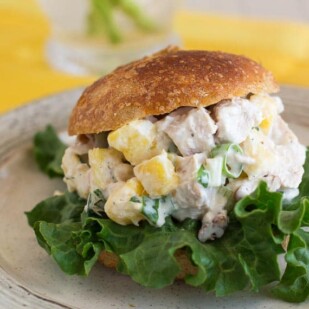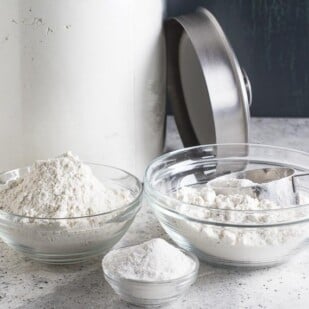No need to go to the local coffee or tea shop for a cup of masala chai! Our Low FODMAP Masala Chai is easy to make and by creating it ourselves, we can control ingredients and make one that is gut friendly and to our personal taste.
Chai is simply the word for tea in India but many of us will think of the milky, sweet, spiced black tea more properly called Masala Chai when we hear the word. We chatted with a few friends, born in India or first-generation Americans – self-proclaimed chai fanatics and one tea sommelier from New Delhi – to gather information that would help us make classic masala chai. And to create a low FODMAP version for you.
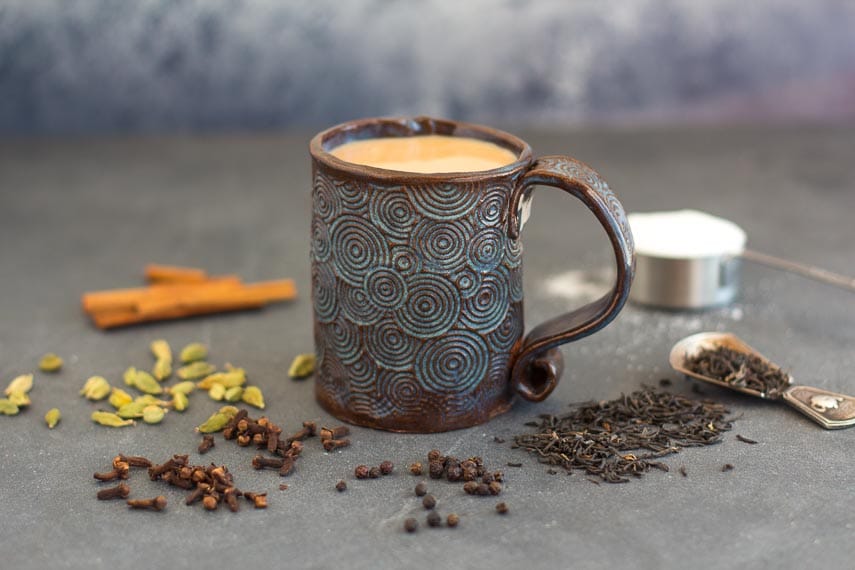
What Is Masala Chai?
Masala means spiced, and chai means tea, so masala chai is spiced tea. It is usually black tea that has been blended with spices, sweetened and enhanced with dairy.
Sometimes the spice highlighted can be just a single spice, like cardamom. Other times there is a complex spice blend. Whole milk is common, but richer milks and light cream can be used as the dairy. It is typically sweetened – sometimes sugar, other times honey or jaggery – or occasionally not sweetened at all. Some feel honey is healing; others believe its potent flavor over-shadows the spices.
The choice of what tea to use comes into the equation as well, although a strong, malty Assam is very common. Some folks prefer loose tea, others tea bags.
As Keertna Sapra, a tea sommelier for No. 3 Clive Road tea explained, “the one aspect of Indian life that transcends class is tea. Whether you are living in the most remote areas, or are a billionaire in your Mumbai mansion, when someone comes to visit you ask them if they would like some tea, and masala chai is what will be served”.
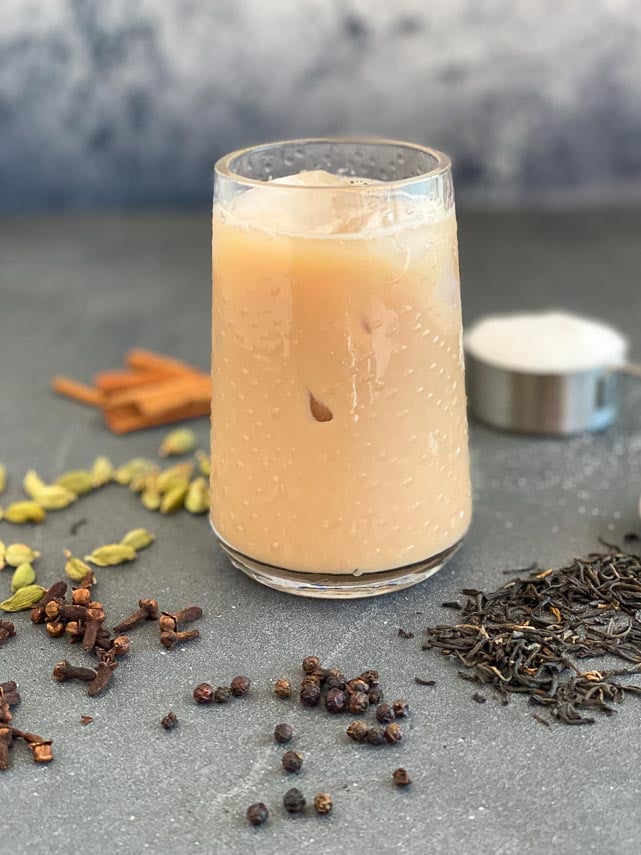
What Spices Are In Masala Chai?
This is a question that has myriad answers. Every household, even each person, will have their own favorite blend, but here are the spices and flavors most often found in a masala chai mixture, along with their low FODMAP amounts, where applicable:
- Green cardamom – low FODMAP in 1 teaspoon, 2 g amounts.
- Cinnamon – low FODMAP in 1 teaspoon, 2 g amounts.
- Cloves – low FODMAP in 1 teaspoon, 2 g amounts.
- Black pepper – low FODMAP in 1 teaspoon, 2 g amounts.
- White pepper – has not been lab tested but will most likely be tolerated by most and similarly to black pepper.
- Ginger root – no FODMAPs have been detected. Fresh has been lab tested, but recipes containing dried ground ginger have been accepted by Monash University.
- Fennel seeds – low FODMAP in 1 teaspoon, 2 g amounts.
- Nutmeg – 2 nutmegs are low FODMAP (which is a lot); 4 g total.
- Saffron – low FODMAP in 1 g amounts.
- Licorice – licorice tea has been lab tested and no FODMAPs have been detected.
- Star anise – low FODMAP in 2 g amounts.
- Holy basil – also called tulsi, this Ayurvedic herb is related to Thai Basil, which has been lab tested, but holy basil itself has not.
- Orange peel – dried, mixed citrus peels have been lab tested and are low FODMAP in ⅓ cup (50 g) amounts.
- Lemongrass – low FODMAP in 50 g amounts.
- Mint – fresh mint is low FODMAP in 90 g amounts.
The spices listed near the top of our list are the most commonly used for masala chai, but we have seen all of these used, sometimes alone (often cardamom or ginger) or more typically in some combination. And in terms of proportion, again, it can be very individualized.
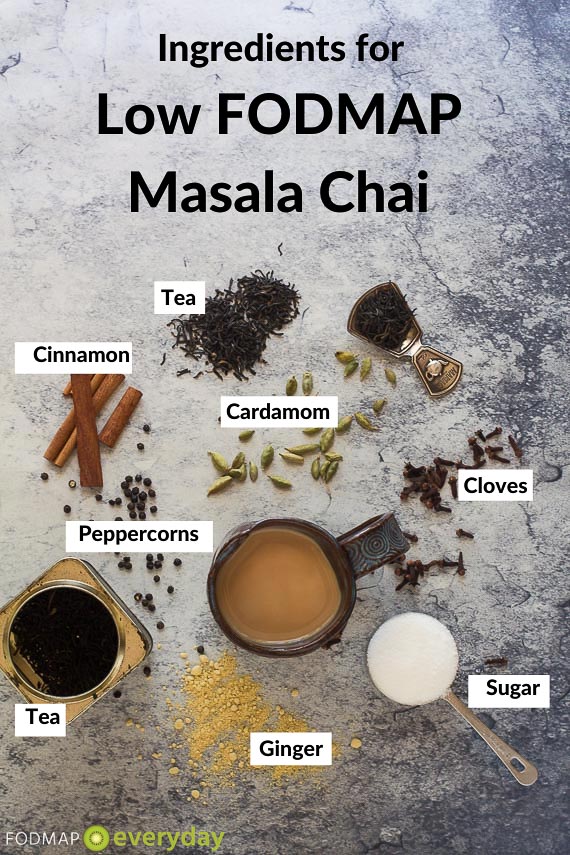
How To Choose Spices For Masala Chai
In speaking with our masala chai experts most agreed on one thing: that sometimes a single spice can be used – often cardamom – and that ginger was often reserved for cold weather months when its warming qualities are most welcomed. It is thought that ginger is too stimulating to use in warmer months. One of our experts said she never uses cloves as she feels they “dull” the flavor of the cardamom, which is her favorite. As we said before, it is all personal decision. And since the spices we are going to use are low FODMAP, we have choices, which is wonderful.
Ayurvedic Medicine
One Indian food expert we consulted, Chef Saira, said that it is really impossible to discuss this spiced tea without mentioning Ayurvedic medicine, or Ayurveda. This is an ancient Indian medical system that focuses on a natural and holistic approach to physical and mental health. Diet is key and choice of foods –including herbs and spices – will be specific depending on what the desired result is.
Chef Saira explained, “what we eat and drink in Indian cuisine reflects seasonality…even for something like masala chai… in the winter we use stimulating spices as our digestion is slower…the masala chai is rich and stimulating and heats the body from within…it is need based reasoning. In cold climates the milk is fortifying and restorative…I will use a lot of ginger in winter as it creates inner heat, like a chili pepper, but I skip ginger in summer”. Chef Saira specified that she never uses ginger in her most common masala chai blend and reserves its use for when it is cold outside, as mentioned above, or perhaps for when she is coming down with a cold.
Prepping Spices
Chef Saira went on to discuss types of ginger and spices: “I will add a few slices of fresh ginger for flavor. Unpeeled. There is a nutritional benefit that we lose if we peel…if I want more potency, I grate the ginger; it releases all its juices… I add the skin of the cardamom as well. It releases aromatics as it boils”.
Chef Saira added that as she is from the north of India, she is more apt to use fresh or whole spices.
I loved how she described using the ground whole spices, which sometimes are not ground all the way to a fine powder. It would not be unusual for a solid piece of this or that to find its way into her cup: “It doesn’t bother me if a whole piece gets in my mouth; we know how to dodge it”. She also made a point of saying, “there is no wrong way” to prepare masala chai.
I decided to try her approach of using the skin of the cardamom pod and liked it very much.
Different Techniques
In addition to choice of spices, there is how the spices are prepped, and then also the approach taken with the tea and dairy varies: what is boiled together when, etc. Again, no wrong way.
- Masala chai can be made with all ground spices and tea bags.
- You can use whole spices, left whole.
- Sometimes there is a combo of whole and ground spices.
- If you start with whole spices, they can be ground in a spice grinder or mortar and pestle
- Some folks like to boil the spices with the milk because they believe that the fat in the milk helps bloom and develop the spice flavors. This is true, but what I do not like about this approach is that you are then committed to a certain amount of dairy.
- I have chosen an approach that is meant to make things simple for you and give great results. See more in the How To Make Masala Chai section below.
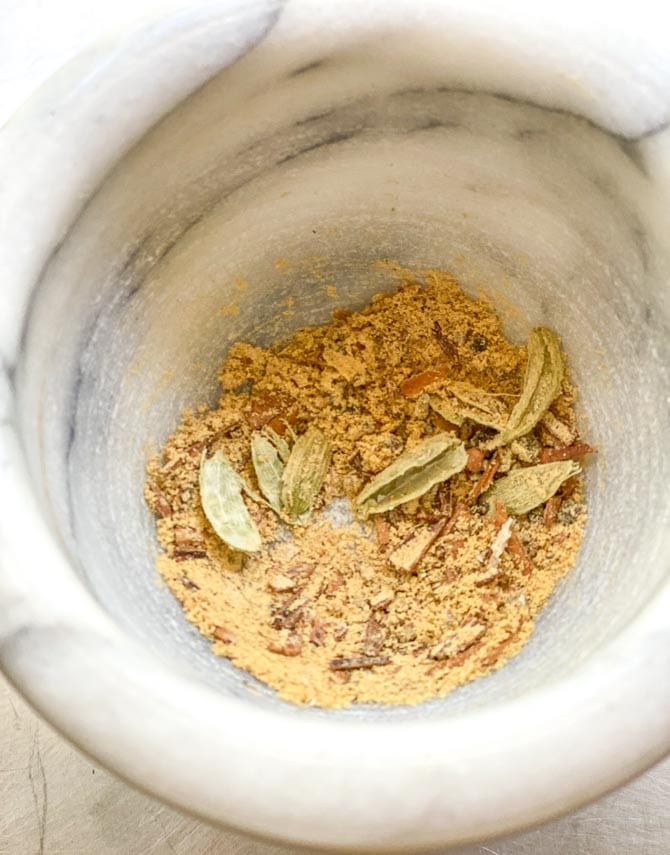
Takeaways From Our Panel of Chai Experts
Years ago, I used to drink masala chai every morning and this went on for years. My approach was to take whole spices and fresh ginger and make a concentrate, complete with tea and sweetener, that I could draw upon every morning over a few days, to simplify my morning routine by just adding milk and heating.
A few things that stood out in my recent research were:
- The majority of those I interviewed used dry ground spices
- Most made what they wanted, when they wanted it. Making Masala Chai was looked upon as an easy, everyday thing, just like brewing a simple cup of tea with a tea bag.
- One person likes to make a large batch of freshly ground dried spice mixture, that would make enough for about 25 cups of masala chai.
The takeaway is that you can make chai with fresh ingredients or dried. You can it by the cup or prep a spice mixture head. I have to admit that I have changed my ways and now always make it fresh to drink immediately.
Choosing Tea For Masala Chai
Keertna Sapra explained that most Indian households will use a CTC tea. Please refer to our article Tea & FODMAPs which goes into this in depth, but basically CTC (crush-tear-curl) is a very fine-grained loose tea (as opposed to a very fluffy tea-leaf style) that brews strongly and quickly and is also economical. It is widely available in India, regardless of where you live, and as it is inexpensive it is accessible to all. You can see it here below.
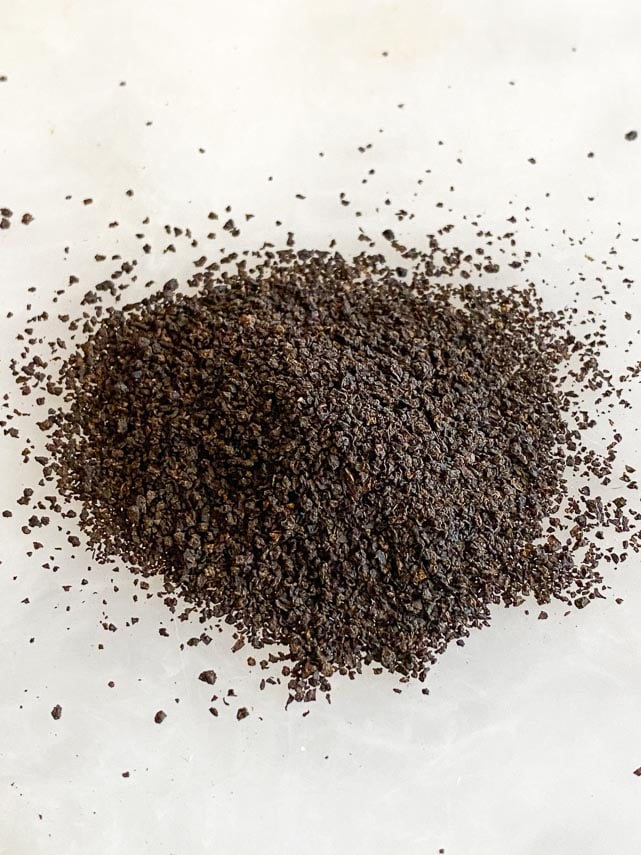
Because CTC teas brew up with a fair amount of bitterness and astringency, the addition of sugar and milk complement this kind of tea very well.
Here are some teas that our panel of experts, and I, recommend:
- Bakri, loose tea
- Bakri, tea bags
- Ghograjan Assam CTC Loose Black Tea from India
- No. 3 Clive Road Assam
- Harney & Sons Irish Breakfast, which is 100% Assam
- Upton Tea Tippy Orthodox Assam FBOP
- Taj Mahal
- Red Label, loose tea
- Red Label tea bags
Decaf Works, Too
Michelle W. from our Low FODMAP for FOODIES Facebook group wanted to make sure that we offered decaf options for those, like her, who need a less buzzy approach. Our Low FODMAP Masala Chai recipe works perfectly with decaf. Come join our Facebook group where we discuss all things food and FODMAPs! Here are some decaffeinated tea choices:
- Harney & Sons Loose Decaf Assam
- Harney & Sons Decaf Black Tea Bags
- Taylors of Harrogate Decaffeinated Breakfast Blend Tea Bags
- Simple Loose Leaf Decaf Assam TGFOP
Dairy In Masala Chai
I have been involved in a lot of discussions about how the boiling of the dairy creates a very full, velvety mouthfeel that every expert we consulted declared is characteristic of masala chai. This is always why whole milk is also used, and never lower fat milk. As one friend put it, “the spices release their flavor better when the milk is “fatty”. Another panel expert went so far as to say that without boiling the milk, the drink would be considered “raw”. One panelist said she uses a 50:50 ratio of water and milk; another said she did not like hers very milky at all.
One thing our panel taught me was that if one has had problems with the milk curdling when using fresh ginger, that switching to ground ginger usually solves the problem.
To ensure that your masala chai is low FODMAP, make sure to use lactose-free whole milk, if using dairy milk. Lactose-free dairy cow’s milk contains no FODMAPs. Add the amount most desirable to you.
Non-Dairy Alternatives
While it is not traditional, you certainly could use a low FODMAP alternative milk. Because you want a thick mouthfeel I suggest sticking with full-fat versions of whatever you choose, as well as unsweetened and plain (not vanilla). I am partial to oat milk and UHT coconut milk for their body, with a preference for the oat milk, such as Oatly, for its more neutral flavor. Keertna Sapra uses almond milk in her daily cup. One thing to note is that not all non-dairy milks take well to boiling. You might have to experiment with brands and specific choices.
Here are some non-dairy milks to choose from with their FODMAP levels:
- Almond milk – low FODMAP at 1 cup (250 ml).
- Cashew milk – So Good Sanitarium brand is low FODMAP at 1 cup (250 ml).
- Coconut milk, canned – low FODMAP at ¼ cup (60 ml).
- Coconut milk UHT – low FODMAP at ¾ cup (200 ml).
- Hemp milk – low FODMAP at ½ cup (125 ml).
- Macadamia nut milk – low FODMAP at 1 cup (250 ml).
- Oat milk – low FODMAP at ½ cup (125 ml).
- Quinoa milk – low FODMAP at 1 cup (250 ml).
- Rice milk – low FODMAP at ¾ cup (200 ml).
- Soy milk made with soy protein (not whole beans) – low FODMAP at 1 cup (250 ml).
How To Make Masala Chai
Just as with the choices of spice, there are different techniques for making masala chai.
Most masala chai devotees say that the tea and the milk must both be boiled – but some boil them together with the spices and others use a sequential technique. Others take a gentler approach and say that unless you use certain hearty black teas, that boiling the tea will ruin that component.
I have chosen my approach to making Low FODMAP Masala Chai for some very specific reasons and they involve taste, ease and digestibility.
- Personally, when I grind whole spices freshly for Masala Chai I find that my stomach gets upset. The spices seem to be too strong for my gut – both stimulating and irritating – so I have settled on an approach that combines whole spices and pre-ground.
- I always have pre-ground cinnamon and ginger around, and because I use them often, I know they are fresh.
- Conversely, I like using whole cardamom in the pod and also whole peppercorns as I find that pre-ground lose their fragrance too quickly.
- Cloves, I can go both ways. I usually have both whole and pre-ground on hand, but tossing 1 whole clove in a pot is so easy.
- I like to boil the spices and tea together to develop both the spice flavors and the tea, This works with a hearty loose tea, such as an Assam, which is what I use. Since I have to strain out the spices anyway, using loose tea is no bother.
- Once the spices and tea are boiled, I add my lactose-free whole milk. By adding at this stage I can go by eye and add as much milk as I like; I just look at the pot and pour in the milk until I hit the right “milky color”. Make sure to bring to a boil.
- At this stage you boil again to slightly reduce and enhance the rich mouthfeel with the milk. Watch out for boil-overs, as milk is prone to do that.
- Then whisk in sugar, taste and adjust sweetening, strain and serve!
Measuring Loose Tea
Let’s look at measuring loose tea. One “serving” of tea is generally considered to be 2 g in weight. If you have a scale, you can use it. Above I showed you what CTC tea looks like. Below is an example of a full-leaf Assam. They measure quite differently by volume, the CTC being much heavier.
Our recipe makes 2 servings, so you will need 4 grams total, but I wanted to show you what one serving looks like:
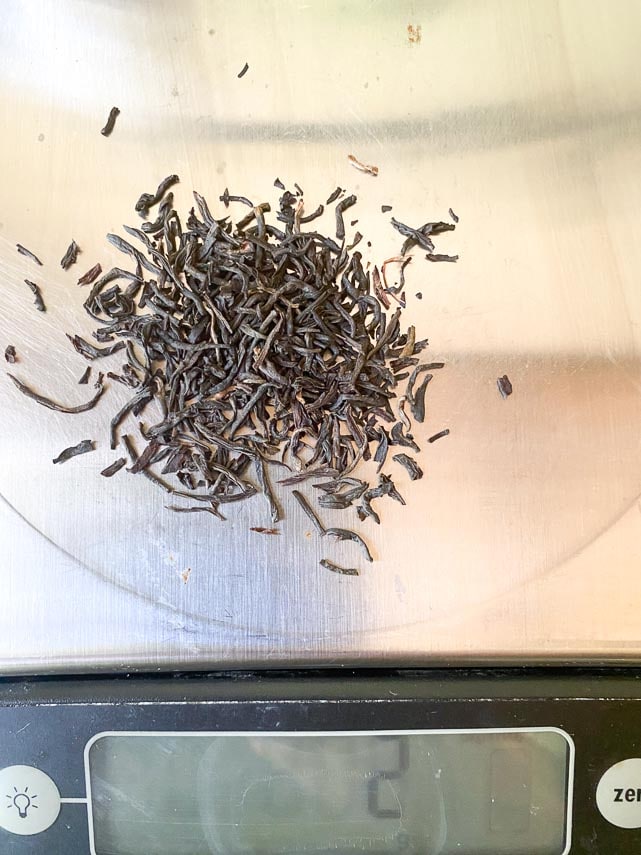
Or if you make tea every day like I do, you get used to doing it by eye, especially if you have a tea scoop that you use again and again. It becomes intuitive.
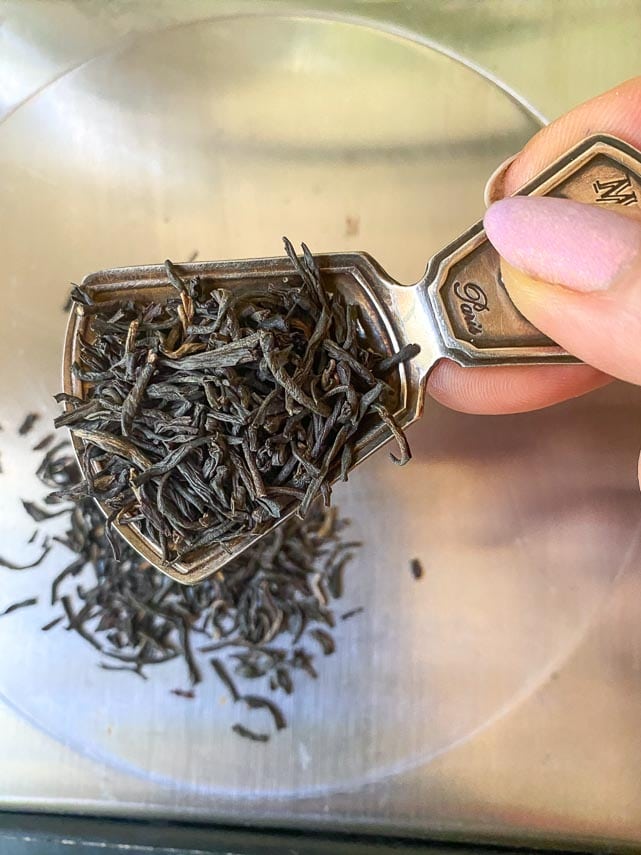
Gather Your Spices
Choose your spices. I like to use whole cardamom, ground cinnamon, whole cloves, whole pepper – and ground ginger is added on occasion.
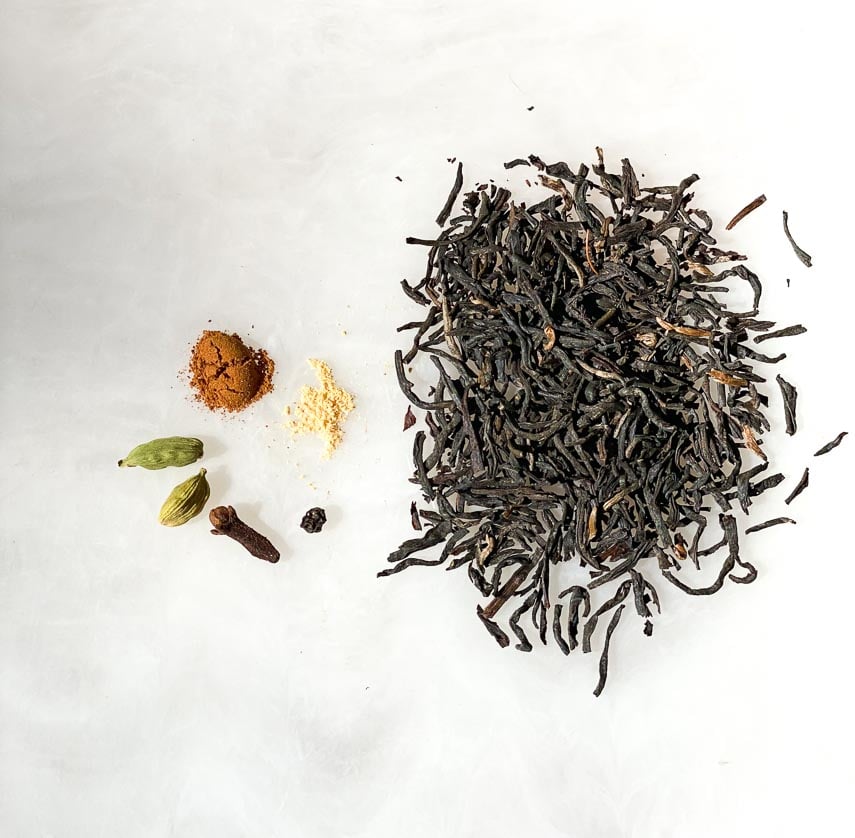
I know it doesn’t look like a lot of spice – trust me and try it as I suggest the first time. Then you can make adjustments.
Add the spices to a pot with water.
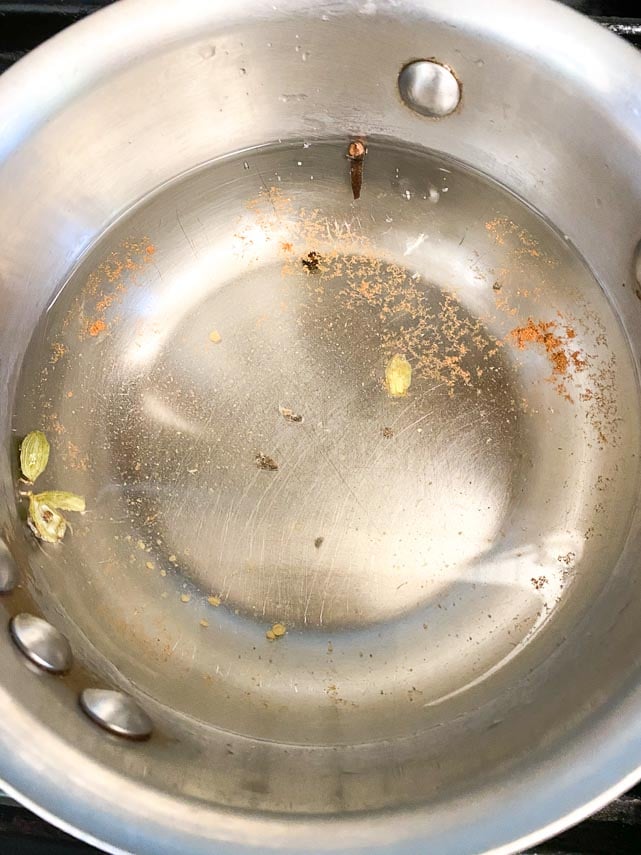
Add the tea.
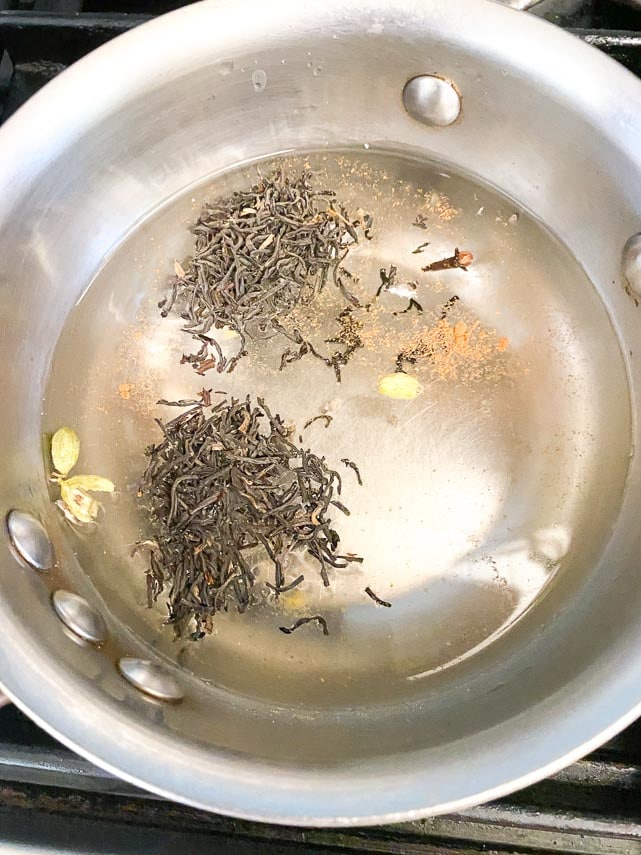
Bring them to a boil, adjust heat and simmer for 3 minutes.
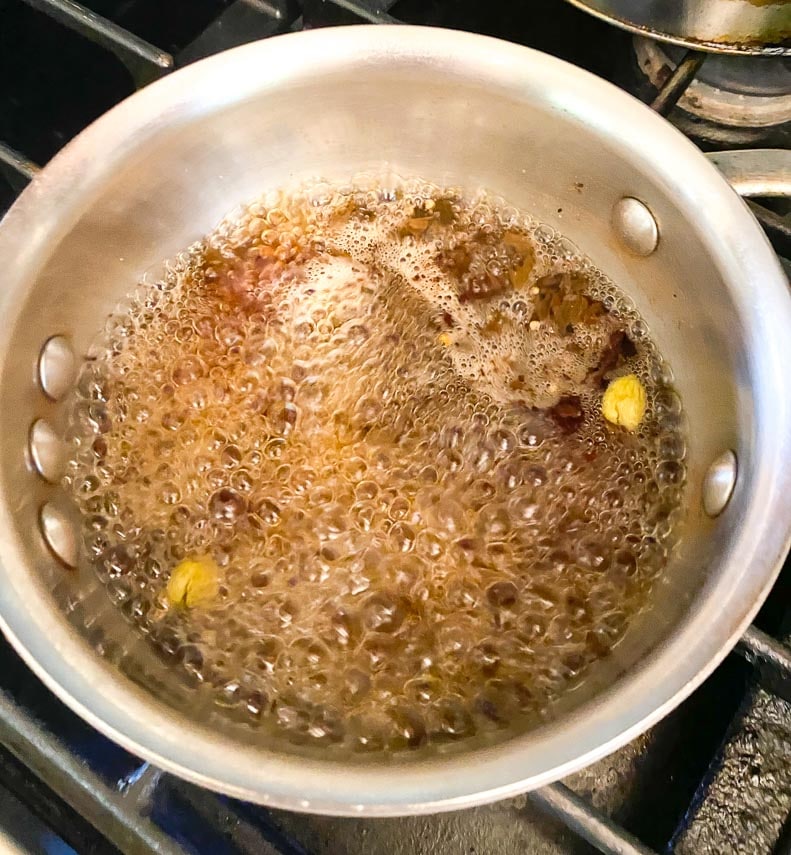
Now add your lactose-free whole milk (or milk of choice) and simmer again for 3 minutes.
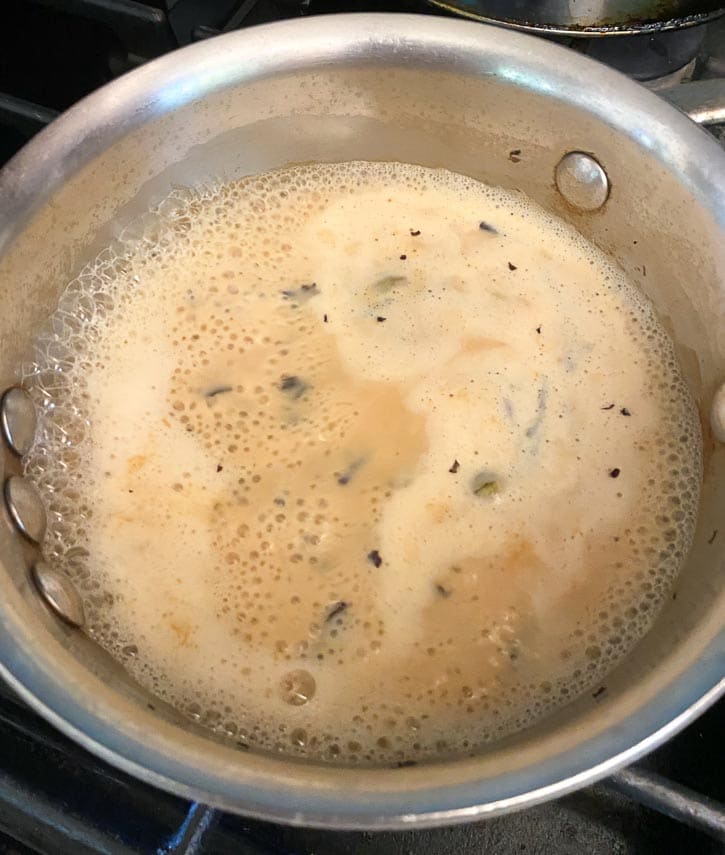
Your chai is now ready to sweeten (I use white granulated sugar), strain and serve.
So, here is our Low FODMAP Masala Chai. Try it and see if you like our blend of spices and our level of sweetness. You can of course use this article as a guide to create your own version.
For a general discussion on tea, please see our article Tea & FODMAPs. It explains what you need to know about how tea is made, how to buy and FODMAP related information.
More Low FODMAP Tea Recipes
- Peach Iced Tea
- Green Tea With Passionfruit
- White Tea With Mango
- Black Iced Tea with Lychee
- Strawberry Arnold Palmer
- Arnold Palmer Popsicles
And if you want to have the blending taken care of for you, try No. 3 Clive Road Madurai Masala Blend. It contains Assam tea, cardamom, ginger, cloves, cinnamon, black pepper and marigolds, which Keertna explained are prized for their anti-inflammatory properties. Marigolds have not been lab tested for FODMAPs so perhaps try this blend when you are stable and in your Challenge Phase.
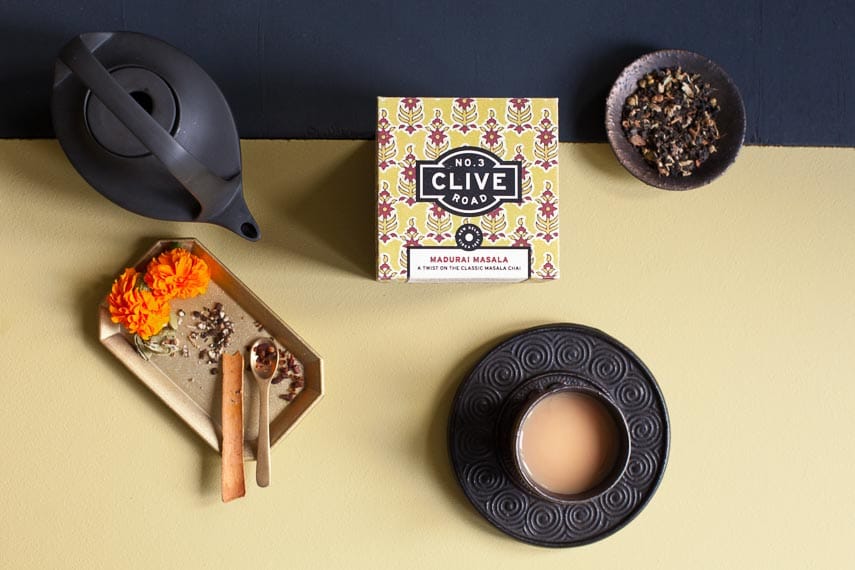
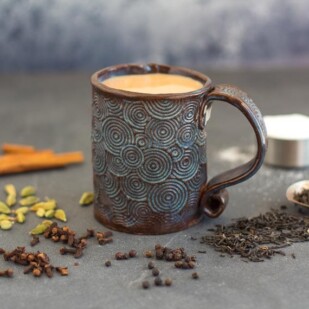
Low FODMAP Masala Chai
No need to go to the local coffee or tea shop for a cup of masala chai! Our Low FODMAP Masala Chai is easy to make and by creating it ourselves, we can control ingredients and make one that is gut friendly and to our personal taste. Chai is simply the word for tea in India but many of us will think of the milky, sweet, spiced black tea more properly called Masala Chai when we hear the word. We chatted with a few friends, born in India or first-generation Americans – self-proclaimed chai fanatics – to gather information that would help us make classic masala chai. And to create a low FODMAP version for you.
Ingredients:
- 1 ½ cups (360 ml) water
- 2 green cardamom pods
- 1 whole clove
- 1 whole black peppercorn
- 1/16 teaspoon ground cinnamon
- Pinch ground ginger; optional
- 1/8- ounce (4 g) loose black tea, such as a hearty Assam
- ¼ cup to ½ cup (60 ml to 120 ml) lactose-free whole milk; or to taste
- 1 to 3 teaspoons sugar; or to taste
Preparation:
-
Place water in a small saucepan. Crack open the cardamom pods over your pot and add them (with skin) along with clove, peppercorn, cinnamon, and ground ginger if using (try without first). Add loose tea and simmer 3 minutes.
-
Add the milk, a little at a time until it is as milky as you like it and simmer for 3 more minutes. Whisk in sugar to taste and immediately pour through a strainer into two waiting cups. Serve and enjoy.
Notes:
Tips
• You can pour over ice to make an iced version.
• Note that some folks find the spices overly stimulating to their digestion. Always eat and drink to your tolerances.
FODMAP Information
Our recipes are based on Monash University and FODMAP Friendly science.
- Black Tea: Both Monash University and FODMAP Friendly have lab tested black tea for FODMAPs. Monash says that a Green Light low FODMAP portion is 180 ml (¾ cup) when “brewed strongly” and made from “1 teabag”. FODMAP Friendly gives it a “Pass” at “1 bag” or 1.88 g.
- Ginger: Monash University has lab tested fresh ginger root and has determined it to be free of FODMAPs, making it one of our go-to no FODMAP foods.
- Honey: Honey has been lab tested by both FODMAP Friendly and Monash University. FODMAP Friendly gives it a “Fail” at 2 teaspoons (15 g). Monash says that while clover honey specifically is only low FODMAP at ½ teaspoon (3 g), they state that honey is low FODMAP in 1 teaspoon (7 g) amounts.
- Sugar: Monash University and FODMAP Friendly have both lab tested white, granulated sugar. Monash states that a Green Light low FODMAP serving size of white sugar is ¼ cup (50 g). FODMAP Friendly simply states that they have tested 1 tablespoon and that it is low FODMAP. Regular granulated white sugar is sucrose, which is a disaccharide made up of equal parts glucose and fructose. Sucrose is broken down and absorbed efficiently in the small intestine.
Please always refer to the Monash University & FODMAP Friendly smartphone apps for the most up-to-date lab tested information. As always, your tolerance is what counts; please eat accordingly. The ultimate goal of the low FODMAP diet is to eat as broadly as possible, without triggering symptoms, for the healthiest microbiome.
Nutrition
All nutritional information is based on third-party calculations and should be considered estimates. Actual nutritional content will vary with brands used, measuring methods, portion sizes and more. For a more detailed explanation, please read our article Understanding The Nutrition Panel Within Our Recipes.
